
Whangaehu












FIRE & ICE









































































Whangaehu












FIRE & ICE
































































































































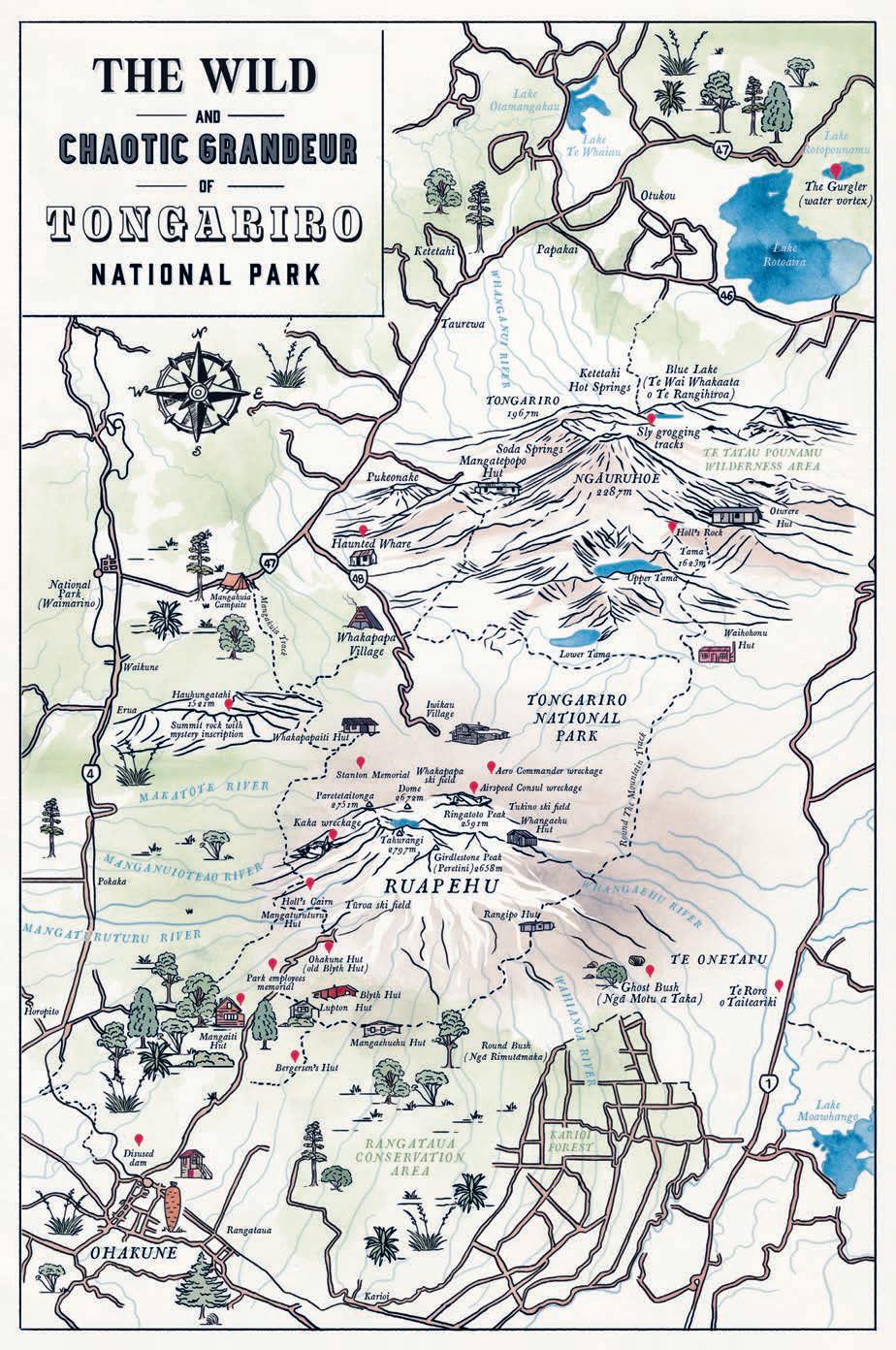

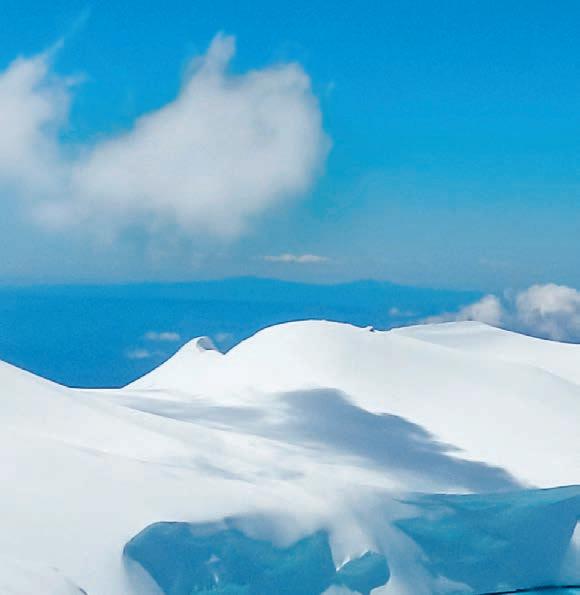

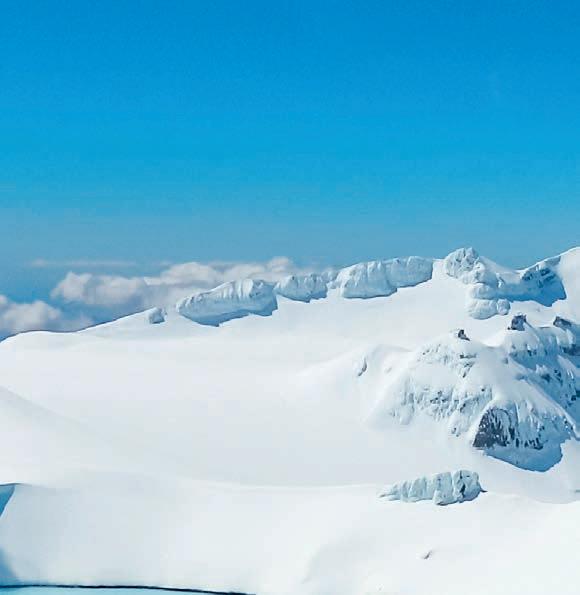

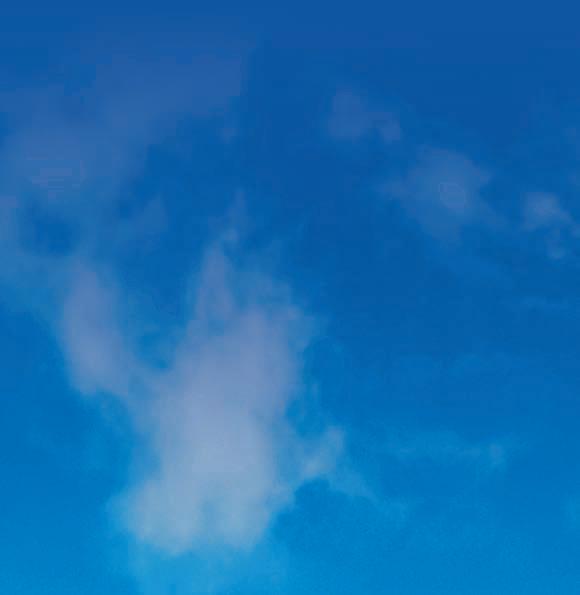
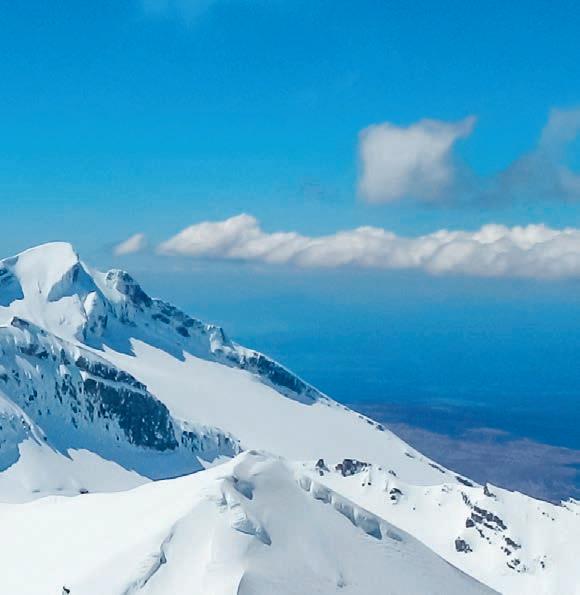
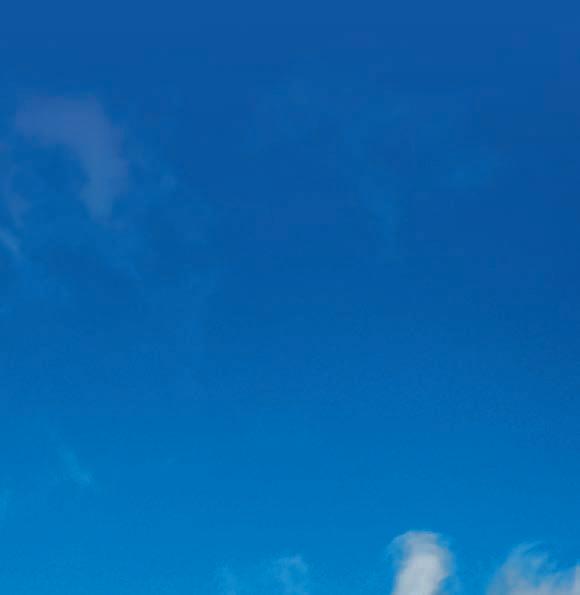
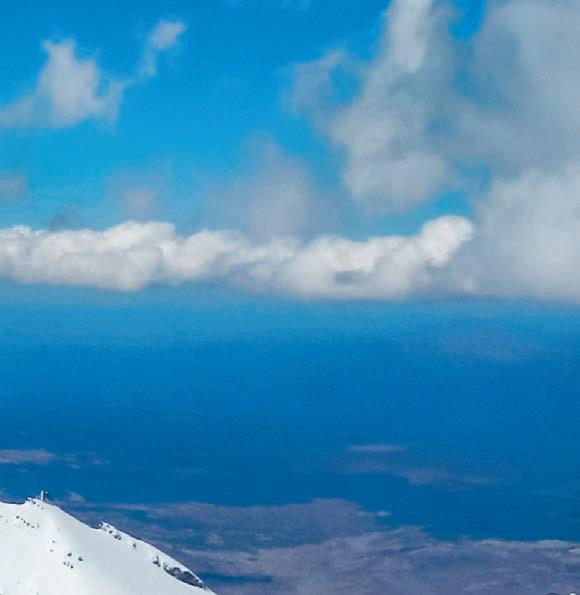

Two members of the Auckland Tramping Club peering into crevasses on the Mangaehuehu Glacier at Easter, 1933. Auckland Libraries Heritage Collections, 282-0426

This book focuses mostly on the European footprint on the mountains of Tongariro National Park. I’m a Pākehā writer, and I take the view that the stories of tangata whenua are not mine to tell. In places, the book occasionally brushes up alongside narratives and histories from te ao Māori. In other places, there are concepts and language that are recognised as offensive in today’s context — for example, where a European explorer refers to Māori guides as ‘my natives’. I’ve let these stand; this book focuses on the site that lies at the intersection between these magical mountains and the notion of ‘this is what we used to do’. Members of the relevant iwi were consulted on sections of the text, and I am grateful for their kōrero.
The text is centred on Ruapehu, which I occasionally choose to refer to as male, but incorporates Tongariro and Ngāuruhoe, and generally takes Tongariro National Park as its boundaries of scope. Roderick Gray, a mountain enthusiast and a shepherd who lived at the head of the Mangatepopo Valley for some years, wrote that the names had once been inverted: ‘The volcano “Ngauruhae” [was known] as “Ruapehu”, the great crater to the east as “Ngaruhae” . . . the whole range took the name “Tongariro” — “Gone south, the place of the departed”.’ He referred principally to Tongariro, whereas I look more towards Ruapehu as the object of my interest — a mountain Gray called ‘an object of wild, chaotic grandeur’.1
This book is a story about mountains, but it’s a story about other things, too. You’ll read about ghosts, fires, avalanches, crevasses and plane wrecks. There’s also love, mysteries, a secret inscription on a summit stone, conscientious objectors being arrested at gunpoint in the bush, sly grogging and carrot waving. It was great fun to research and write, and I hope it’s equally fun to read. Most of all, I hope you, too, feel the urge to embrace the wild and chaotic grandeur of Tongariro National Park.

Ibecame obsessed with Ruapehu about a decade ago, when I saw a photo of people bathing in Te Wai ā-moe, Ruapehu’s Crater Lake, in the 1960s. In the shot, a woman in a fashionable bikini is waving at someone. A pair of skis is stuck upright in the snow, and another swimsuit-clad woman reclines nearby. It’s summer, and three men and a woman are bathing happily in the lake’s tepid waters. The photo was commissioned by the New Zealand Tourist and Publicity Department to promote travel to Tongariro National Park. Things have changed — Crater Lake is known to be acidic, access is challenging, and it is now recognised that swimming there is culturally offensive — but for a time this was considered the ultimate in shiny tourist glamour: to take a snowcat ride up the Whakapapa Glacier, strip down to your swimwear, have a dip, and ski down.
The photo of the bathers appeared in a book called Skiing on the Volcano: Historical images of skiing on Mount Ruapehu by Karen Williams and Dave Bamford. A er I came across a copy in my ski club’s lodge I pored over the pages, scrutinising each image to get a picture of what mountain life used to be like. I became the proud owner of a life pass to the ski fields on Whakapapa and Tūroa, climbed the peaks, ski-toured the glaciers, tramped all the tracks and visited all the huts several times over. I thought I knew the mountains, but every time I turned a corner, something new surprised me.
I wanted to know Ruapehu, the mountain I loved so much, more thoroughly — not just the ski fields, the huts, tracks and summits, and not just what was declared openly on the map. I also wanted to know what existed once you stepped off the path. What lay in places people seldom trod? What were the stories? Were there treasures still out there that people didn’t really know about? What would Ruapehu allow me to find if I went gently and asked respectfully?
︿︿︿︿︿
Skiing on the Volcano represented a slice of time in the history of Ruapehu, and so does this book. Ruapehu and Tongariro have been affected by the very European-coloniser perspective of using mountains as tools for tourism or as tools for capitalism. They’ve also been touched by the equally European notion of ‘conquering’, especially summits. I wanted to create for myself a nuanced shi in mountaineering, to go beyond the question of ‘should I stand on a summit’ and to overhaul the whole way we think about our relationships to mountains and our wild spaces. A mountain is more than just a summit, and a peak is such a small part of a mountain’s whole being.
I came across the term ‘orophile’ — someone who loves mountains — but the emphasis here is on love, really, more than on mountains. I think you can be a
mountaineer who loves climbing and thrives on physical challenge but doesn’t truly, properly love the mountains. And in the same way, you can be an orophile, someone who loves mountains, without ever ‘conquering’ a summit.
This book is structured according to the elements, a classical concept of defining ma er as simpler substances. Earth, air, fire and water were common elements across ancient cultures, and many also had a fi h element such as ‘void’. Aristotle included the fi h element, aether, to describe something that defied encapsulation by tangible material. His reasoning was that the stars were not made from any of the four elements but from a completely different, heavenly substance.
It’s hard to define why Ruapehu holds such magic, but its allure is felt by the many people who are drawn to its slopes every year when the snow falls. Ruapehu on a good day, we agree, is the best place in the world to ski. A good day, when the snow is stardust beneath our feet. Elements, even aether, will never properly capture the seductive a raction of Tongariro National Park, but Ruapehu’s ice and fire is a captivating portal that will let us in.
In the 1870s George Beetham, today acknowledged as the first known European to have properly summi ed Ruapehu, saw himself very much as an outsider. He was disappointed when his prospective companion, William Birch, couldn’t climb or travel with him to the mountains. Beetham wrote that not only had he looked forward to the pleasure of Birch’s company, but he also felt ‘rather like a poacher a empting Ruapehu, I being a manuhiri (visitor), without the countenance of one of the old se lers of the district’.1
I also still felt like an outsider, a pretender, even though I lived a mountain life. Yet in other ways, being on or around Ruapehu always felt like being home. I realised I’d become addicted to Ruapehu, but my obsession wasn’t about peaks; I’d begun to view Ruapehu as a greater whole, a feeling, or perhaps, a person. I knew the mountain contained some kind of magic, for all of us, and I wanted to capture that and put it on the page.
Our historic ascensionist George Beetham, too, was deeply touched with the Ruapehu infatuation. ‘During the month of March, 1878, I found myself for the first time for many years with a few weeks’ spare time at my disposal,’ he wrote. ‘Therefore, I determined to gratify a wish that had taken possession of my mind for many years, to visit the volcanic district of Ruapehu and Tongariro.’2
The volcanic mountains of the central plateau have gripped me and held me tight. I’ve spent two years writing and researching, looking for locations and coordinates, rifling through archival material, and walking and climbing to find memorials, plane wrecks, old hut sites and more, in the wild world of Tongariro National Park.
This is the story of how Ruapehu and Tongariro took possession of my mind.
Two climbers on the edge of TeWai ā-moe, Ruapehu’s Crater Lake. Tahurangi (the highest peak) is in the background. Auckland Libraries Heritage Collections, 1865-54
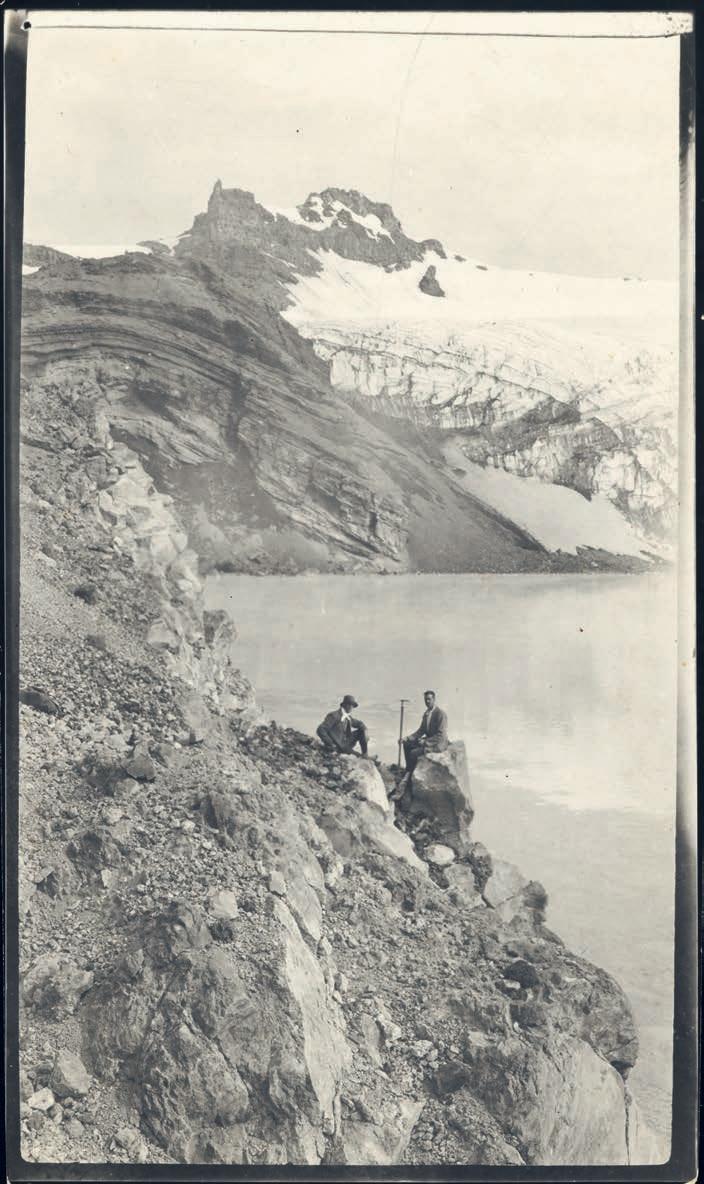
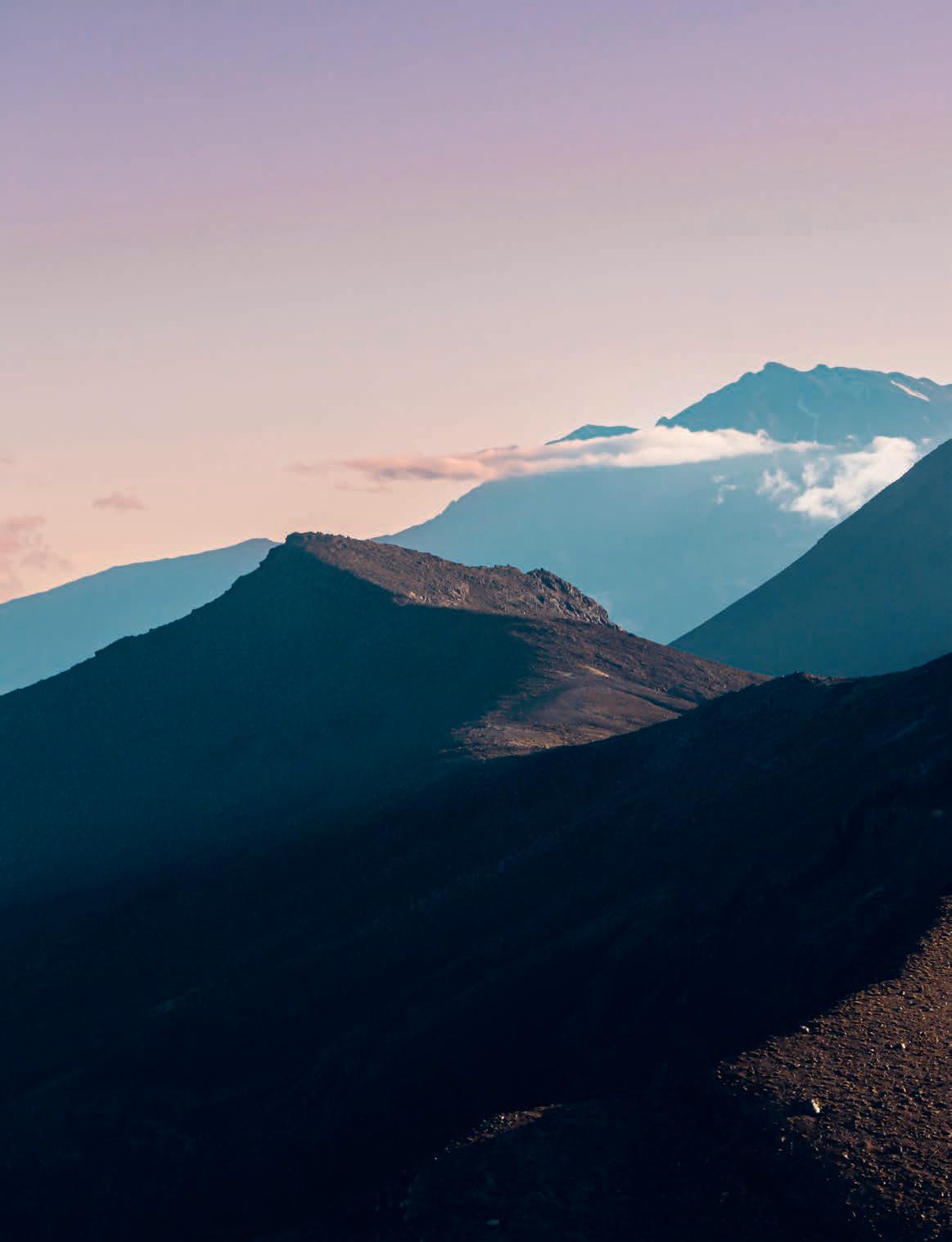
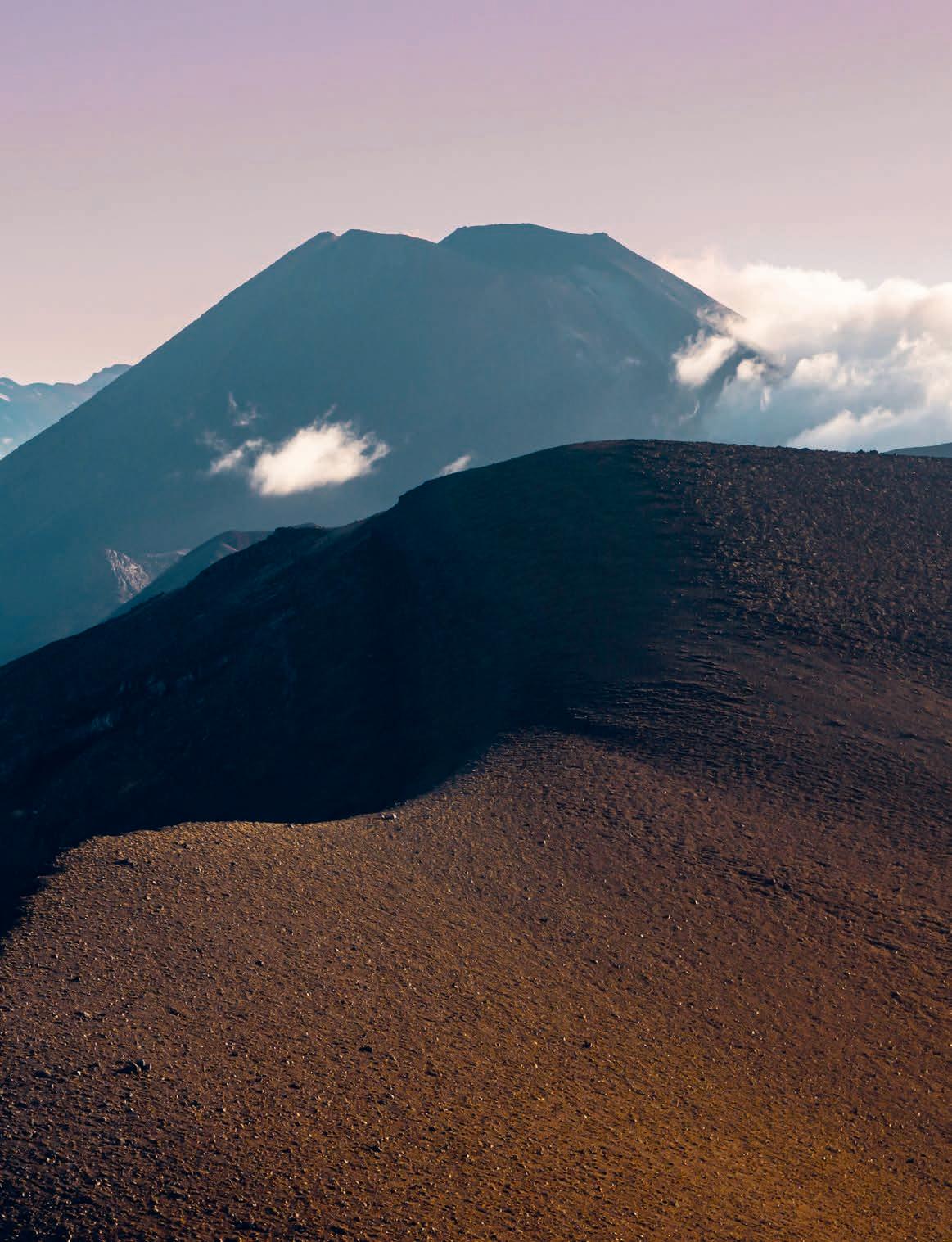
And then of course we went back to Ruapehu, drawn back again and again as if the mountain were a white magician who, in exchange for our lives, had gripped us in his icy thrall for ever after.
— Susan Graham (aka‘Fitzie’Morris)1
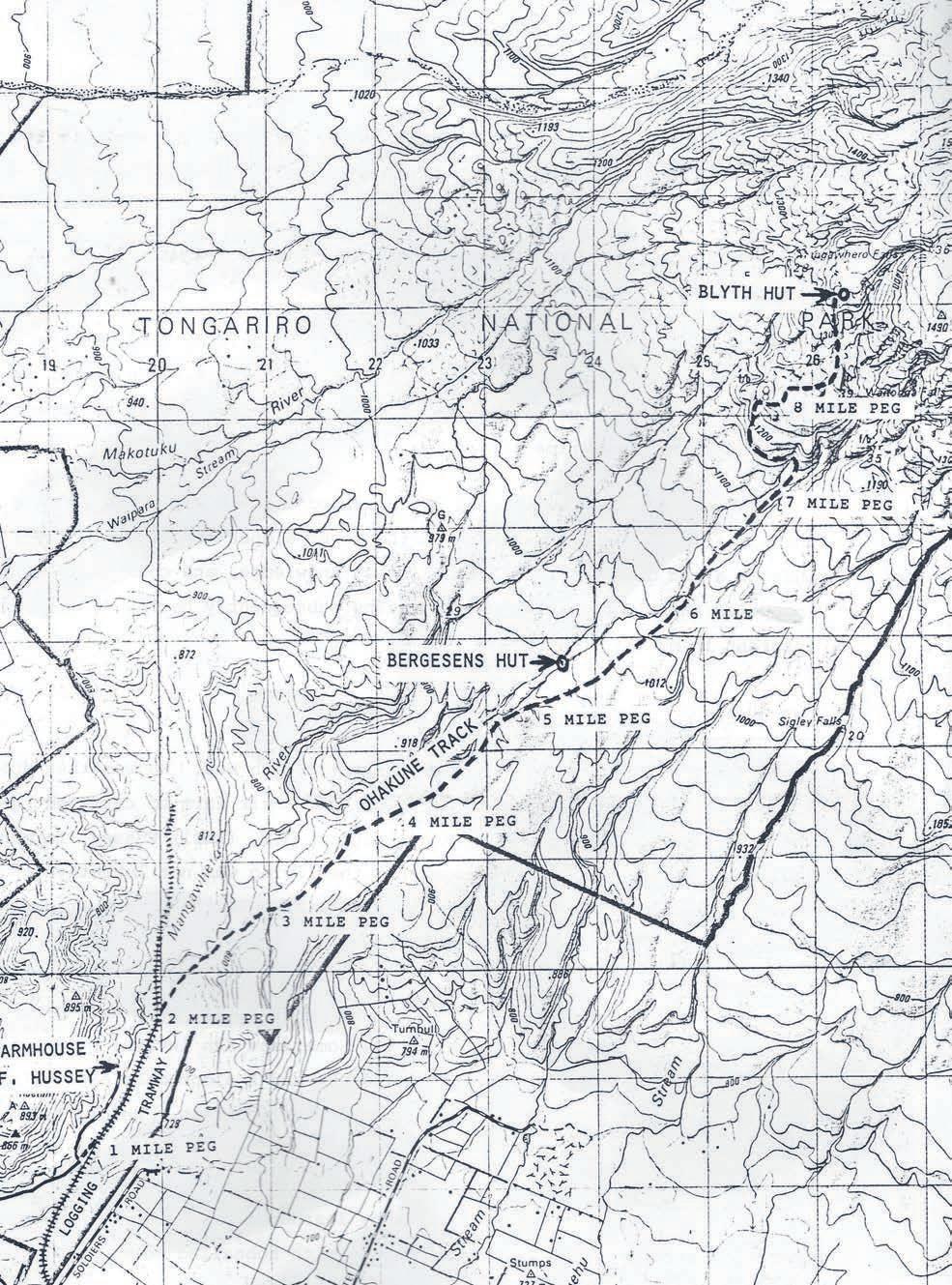
During the Second World War, two men called Bergersen built a couple of huts on the southern side of Ruapehu to avoid conscription. Both men were labelled conscientious objectors and one was arrested at gunpoint. Could we find their huts, nearly 80 years later, in the tangled and frigid Mangawhero Stream?
Ohakune, 1942. Auckland, gripped by an ongoing dry spell, was relying almost entirely on the small mountain town for its supplies of green vegetables; pigeon racing was hotly contested between the regions, and birds were liberated from Ohakune to race more than 177 kilometres; a track was cut from the Junction to Mangaiti Hut; and a long-haired defaulter was captured on the southern slopes of Ruapehu.
Ohakune gardener Merv Bergersen had failed to report for military service when he was first called up on 27 April the previous year. Instead, he took to the bush, where he built a hut, fi ing it out with bunks, tools and goods.
Six weeks before Merv’s arrest, members of the Ohakune Home Guard had been exploring the bush on the mountain and were about five miles from Ohakune when they came across a sign placed incorrectly on a track. They quickly figured out that it was a ruse, designed to divert trampers from a new track that led to Merv’s hut. They spo ed two men in the vicinity, and one was their man. A warrant for his arrest was issued and police organised a search party, pushing their way through the dense bush for five hours to reach the hut. It was empty. A note that read ‘Gone down Horopito track’ did not put them off the scent: Merv was found hiding in a paddock behind the shack. He’d been hiding for a year by that stage, and hadn’t seen a haircut in several months. He also sported a thick, bushy beard.
Merv pleaded guilty in the Ohakune Magistrate’s Court and was sentenced to one month in jail followed by detention in a camp for military defaulters. It’s unclear how long he was detained for, but archives suggest he spent at least the next three years in the camp; the authorities denied his application for release in August 1945, just a month before the war ended.1
In 1943, a year a er Merv was caught, his uncle Les, a carpenter who also lived in Ohakune, was called up for military training along with scores of other men from the Whanganui military district. Four were from Ohakune and ‘L. J. Bergerson’ was among them. The surname, a Norwegian one, is o en misspelt, but it was Lesley John Bergersen, Merv’s uncle. Les was having none of it. He’d appealed the ballot in July 1942 on personal grounds and had only got a short stay of relief until 30 September. Les was married with a family, and his desire to avoid war had been influenced by his brother’s experiences in the First World War. Les also took to the bush, where he built his own hut. Although avoiding conscription was controversial and generally frowned upon, a few local supporters assisted Les by stashing supplies in the thick forest around the lower southern slopes of Ruapehu.
It’s thought that the Bergersens built more than just the two huts. One was reported to be close to the bo om of what is now the Ohakune Mountain Road, and the other not far from the Old Blyth Track, which was then reached by a foot and horse track. The upper hut demonstrated Les’s carpentry skills; it was hewn from kaikawaka, felled using his broadaxe, which he stashed under a loose floorboard. The hut had a corrugated-iron roof and a shingle on the door that read: Bergersen’s Hut.
Some reckon Les was captured at that hut in 1944, but there’s a thread of a story that he avoided ge ing snapped until much later, when he was out of the area altogether.
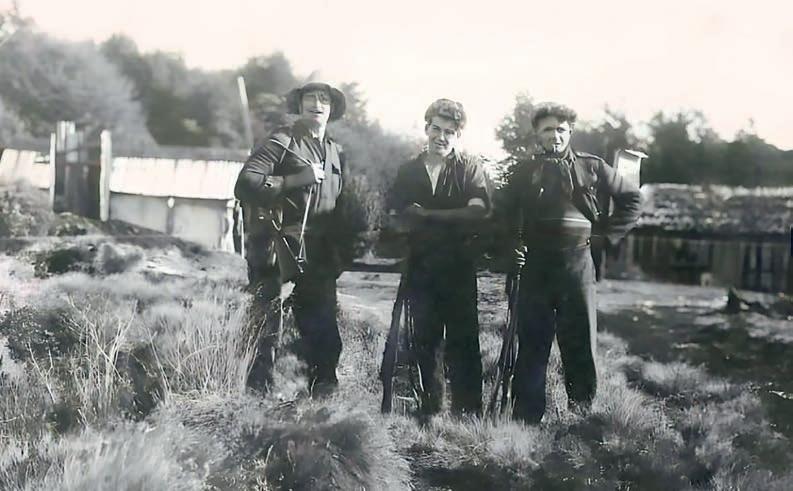
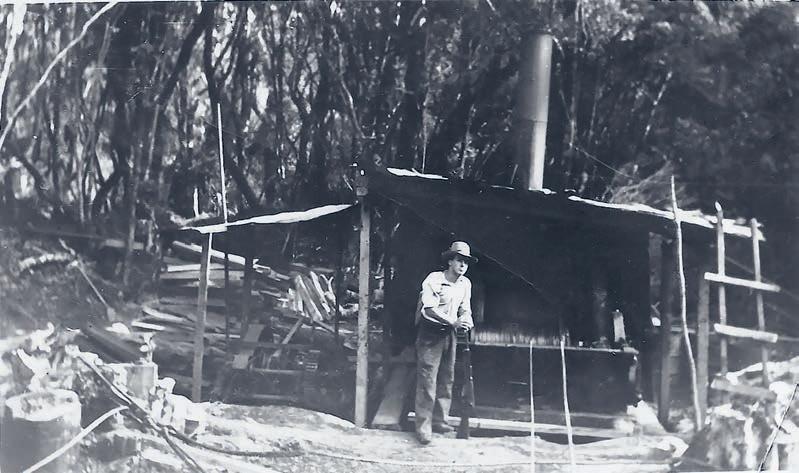
I stumbled across the story of Les Bergersen first, while researching another historical thread entirely. An online search provided a link to an ebook compiled by a master’s student in archaeology that had site records of historical interest listed at the end. It described the Bergersens’ huts as two sites in the Ohakune area occupied by Les and Merv Bergersen while they were evading conscription at different points during the Second World War. The upper hut site had last been visited in 2012 and was considered to be in ‘fair’ condition, the report stated — the site, I assumed, not the hut itself. It was highly unlikely that the structure was still standing, no ma er how good a builder Les had been.
As I began to search, initially for information about Les, the spellings threw me off track: Bergerson, Bergesen, Bergeson, Leslie, Lesley. I put in a request to the National Library in case an archivist there could offer me a lead. Neither Les’s nor Merv’s births were registered in New Zealand, I was told, and although there was a death registered for Leslie Alfred Andes Bergersen, he had been born in 1938 and had died in 1979, so he couldn’t be the Les I was looking for.
Eventually I found some more concrete information, se led on what I deemed to be their correct names: Lesley John Bergersen and Mervyn Stanley Bergersen. Their middle names helped — searching for newspaper stories about ‘Mervyn Stanley’ meant that although a few other unrelated Mervyn Stanleys were thrown into the mix, it didn’t ma er how the surname was spelled, and it yielded results.
I got coordinates for the upper hut site from the ebook, and then found more while rifling through old papers in the DOC archives in Wellington. A er placing them all on my topo map app, I had a total of four potential sites to check out. Three were consistent with reports that the upper hut was ‘west of the five-mile peg’ on the Old Blyth Track, while the fourth lined up with the intel that a hut was situated ‘not far’ from the Ohakune ranger station.
But man, they were hard to find. ︿︿︿︿︿
I started with the Old Blyth Track. It is named for Joe Blyth, the only person who was probably more obsessed with Ruapehu than I am. A keen tramper and climber, he reportedly ascended the maunga 147 times — and that would’ve been from Ohakune Hut just below 1200 metres, making it a 1400-metre day out. This was a far more arduous and extensive undertaking than my habit of ‘popping up’ from the top of the Far West T-bar on Whakapapa, a ‘summit trip’ of perhaps 400 metres’ ascent to visit one of the peaks (I was totally cheating).
Blyth wore a few different hats. He was appointed headmaster of Ohakune School in 1909 and was instrumental in constructing the Blyth Track (now the Old Blyth Track), which runs parallel to the Ohakune Mountain Road and joins with the Waitonga Falls Track. If you really wanted to climb Ruapehu while maintaining historical integrity, you’d start from the bo om of the Old Blyth Track at around the
8-kilometre mark on the road, then grovel up through mud and bush before joining the track to the new Blyth Hut. Blyth and co cut rounds of logs and tree branches and laid them across the track to try to mitigate the mud, but even then horse traffic cut it up very badly and Blyth himself labelled the track in its earliest days ‘an elongated bog’.2
The cut wood was designed as an anti-bog tool, a corridor, but in its modern incarnation this is a failure; the smooth wood, once wet, becomes hilariously slippery. Imagine railway sleepers, only closer together, but then interspersed with sections where they are absent altogether and where it behoves the cautious tramper to poke around at muddy areas with a pole before commi ing. Some of these areas have wood hidden just below the wet surface while others allow the unsuspecting tramping boot to plunge in above its top, filling it with mud and making that concerning sucking sound when retrieved by force.
The Old Blyth Track is at such a gentle gradient at that point on the mountain that the water simply doesn’t run off. I don’t mind a gentle gradient, so on my first foray to find the Bergersens’ huts I wombled right past the point where I was meant to turn off and begin bush bashing.
I reckoned the men would’ve wanted a good reliable water source, so they’d have placed their huts close to a stream but not so close as to get flooded if the stream ran high. The site would need to be far enough off the main Old Blyth Track that passers-by wouldn’t inadvertently stumble across it and ask inconvenient questions, but again, not so far that it required a large effort of bush-crashing to reach.
I backtracked, watching my GPS for just the right spot, then le the track and made for the stream nearby, looking around as I went for a potential clearing, signs of an old track, or anything that might tip me off to a prior human presence, albeit a long time ago.
Sometimes you get a sense that Ruapehu is allowing you in, and this was one of those days. Gaps at just the right places in the bush called my name and subsequent gaps allowed me to pass through without having to ba le too many obstructions. I don’t really like the idea of ‘bashing’ Ruapehu or his slopes and forest; I prefer the idea of moving quietly and stealthily through, just touching him gently.
I navigated sections of bush lawyer, wet and mossy limbs, overgrown grasses and an inordinate amount of bush li er on the forest floor. It occurred to me that any hut remnants could be covered by decades and decades of leaf ma er, twigs and windfall, and unless there was something incredibly obvious that had stood the test of time — a chunk of corrugated-iron roof, for example — realistically I was unlikely to actually find anything.
Eventually I stumbled upon a clearing, a small but distinct clearing, with a view directly above to bright blue sky, unobstructed by treetops. I checked the topo map. I was right on top of the pin I’d set. This could well be it.
I fancied, though, that this site was marginally too far away from the stream. It also had a steep drop down to the water source, which wouldn’t be ideal for daily living. The ground was covered with layer upon layer of years of windfall, too hard to li or poke through except on its surface layers, as well as leaves, broken branches and mud. This could well be it, but I’d never know.
I became properly obsessed with the Bergersens and their lives. A research approach of wearing out the soles of my tramping boots was one thing, but I knew I’d need to do some more desk research if I really, properly wanted to know about Les and Merv and their huts. I fired up my laptop and shot off information requests, starting with the National Library and Archives New Zealand. A researcher at Archives New Zealand replied swi ly: they held nothing on either man, and had tried all the various spellings of their names. They pointed me to the Police or perhaps the New Zealand Defence Force.
I put in an Official Information Act request to Defence and promptly forgot about it, until one day when I was up on the mountain cleaning up rubbish in the waterways I got a call from a withheld number.
‘Hello Hazel,’ a rushed female voice said. ‘I’m from NZDF Personnel Archives and Medals.’ She said it so quickly that my brain scrambled to make sense of the name. ‘Look I’ve got these files on the Bergersens. What’s your address and I’ll courier them to you? We’re on a deadline.’
I knew nothing about a deadline but I ra led off my address, and the next day a slim volume arrived at my door. Two branded folders contained all that the New Zealand Defence Force held on the Bergersens. Les’s file was inexplicably thicker than Merv’s; I knew Merv had been caught but I had thought Les might have evaded the authorities entirely. I’d found a media report about Merv’s capture and nothing about Les.
Reading the files, Les was an enigma. Incongruently for a man who’d gone to some lengths to avoid conscription, it seemed — if I was reading the files correctly — that he had either been awarded, or been recommended for, two medals — the War Medal and the New Zealand War Service Medal. The file also confirmed that he’d appealed his call-up in May 1942 on grounds of public interest and undue hardship and had been given a stay until September. I asked an army mate to check the paperwork and he confirmed I was interpreting it correctly: Les had been awarded both medals.
A er his stay ended in September 1942 Les had disappeared for the next couple of years. He’d le his home town of Ohakune to go bush, or to join a shearing gang in the Wairarapa, or to go to the South Island where he was later caught, or possibly all of those options. He’d failed to notify his change of address, an act that could result in a charge of desertion. By late 1942 the hunt for Les was in full swing. Police memos noted he was 31, stood five foot nine (he was definitely taller, though, well over six foot), of good physique and fresh complexion, with brown hair and grey eyes, and le ers went back and forth between police and the army.
Reading the correspondence in the file felt like the wri en version of an episode of Fawlty Towers. Les might be with a shearing gang over in the Wairarapa, his wife told police; she hadn’t heard from him in ages. ‘That is all I know,’ she finished, and sent Les’s conscription le er back to the military. The military wrote back: ‘Please treat this ma er as urgent as Mr Bergersen is regarded as a defaulter and the usual defaulter action is being instituted forthwith.’
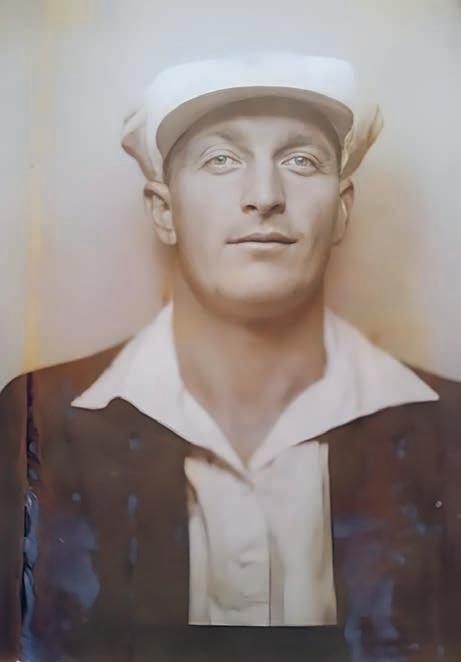

A police memo sent to the military area officer in February 1943 summed up the situation as the Whanganui Inspector of Police knew it:
You may recall that his cousin [sic], Mervyn Stanley, was arrested by police when he was or had been living in a hut on the side of Mt Ruapehu. Leslie John Bergersen [sic] was suspected of carrying supplies to the cousin. Masterton police cannot trace [him]. Ohakune police say that information received indicates that Bergersen had been seen prior to Xmas last or during Xmas holidays in the vicinity of Aramoho [near Whanganui]. Mrs Bergersen claims she has not heard from her husband since the receipt of the Masterton dated le er. It is unlikely that she will assist in any way. Enquiry is being made at Aramoho.3
Les was finally arrested two years later, in January 1945, not in Ohakune or Aramoho or anywhere near Ruapehu, but instead in Blenheim. He was caught using a false name, Les Jensen, and given two months’ imprisonment for the false name and another two months for failing to report. In one of the notes from the time of his arrest it says he was ‘fit for detention with hard labour’. He was in prison only until mid-March 1945, when he was released, but evidently he was compelled to serve in the military, six months before the war would be over. He was almost 35 when he was discharged, in October 1945, just a month a er the war ended, with medals pinned to his chest.
Merv’s file is stamped with a large scarlet brand: ‘Conscientious Objector. Refuses to take oath’, the oath being, ‘I, Mervyn Stanley Bergersen, do sincerely promise and swear that I will be faithful and bear true allegiance to our Sovereign Lord the King, and that I will faithfully serve in the New Zealand Military Forces against His Majesty’s enemies, and that I will loyally observe and obey all orders of the Generals and Officers set over me, until I shall be lawfully discharged. So help me God.’4
Merv had shown up for a medical examination and to be ‘graded’ in June 1941 but disappeared shortly a er. He was caught 11 months later and sentenced to one month’s imprisonment, followed by detention in a defaulters’ camp on a charge of failing to report. Merv’s file showed he ‘failed to report’ four times.
‘Prior to his arrest he had been living in a newly built hut on the side of Mt Ruapehu,’ a note from the Whanganui Inspector of Police informed the area officer. ‘This information had been supplied to you by members of the Home Guard stationed at Ohakune but no action could be taken by police until your request for prosecution was received.’
Turns out Merv was targeted by an angry local. His file shows it was an Ohakune resident, T. Gover, who was irate that Merv hadn’t reported for duty; Gover had penned several le ers to police complaining about it. The first one read:
I am taking this opportunity of writing to you. This concerns a young chap by the name of Mr Mervyn Bergerson [sic], who has been called up five times to enter camp, it’s a year in May since he was called in an overseas ballot. He has no intentions of going into camp and there has been nothing done or said
about it. It’s not that he’s a conchie objector as it’s nothing to him to go shooting animals etc. Don’t you think it’s about time someone looked into the ma er. Do you think it’s fair that other mothers and fathers have to part with their sons, as I did, with three of mine, to fight for the likes of this Mr. Bergerson [sic] who’s had his freedom for a year and still having it. Another chap would have been collected before this time. The police can’t do anything until they have a warrant for his arrest, as they can’t make it out themselves why he’s not in camp and all the other chaps have gone. This chap lives in Rangataua Road, Ohakune. If it’s good enough for other boys and wives’ husbands it’s good enough for him.
Hoping you’ll see into the ma er.5
A lack of action prompted Gover to write again. He continued to complain about Merv’s continued freedom, ‘which makes it the fourth time and yet there has been nothing done about it and he is still walking about having his freedom while the rest of the boys are fighting for him’. ︿︿︿︿︿
During the First World War, the National Registration Act 1915 required every man aged between 17 and 60 to register for service. They were required to state their willingness to fight in the war, specifically to serve beyond New Zealand. During wartime, it became a common sight in small towns for men to parade to service accompanied by the sound of martial music, men dressed in Army khaki or the blue Air Force uniform and the still bluer hue of the Navy dress. From the earliest, ‘defaulters’ who failed to register faced consequences, including social persecution. Shortly a er the Act was passed, Prime Minister Bill Massey stated that there would be ‘consequences’ for those who didn’t comply: ‘We cannot allow any individual to shirk the responsibility.’6
Conscription was introduced the following year, requiring all non-Māori men aged 20–46 to register, sorted into married/recently married and bachelors. Men could object and appeal to the Military Service Board on grounds such as family hardship or conscientious objection. If their appeal was declined and they still refused to serve, they were imprisoned.
Archibald Baxter, father of poet James K. Baxter, was arguably the country’s most famous conscientious objector. He was imprisoned and wrote of his experiences in his book We Will Not Cease. In 1918, Baxter was sent to the front line in France, to a place called Mud Camp, where he and three others were sentenced to ‘field punishment number one’ in a bid by the military to make an example of them. The punishment consisted of being tied to a tilted post in a field, their hands, knees and feet tightly bound. Blood would drain to their feet and it was known to be excruciatingly painful. The punishment was usually applied for eight hours, but on two occasions Baxter was le there for 12 hours or more. He collapsed and was taken to a French hospital, where he was diagnosed with ‘confusional insanity’.
There was intense public feeling over conscientious objectors, which continued in the Second World War, as can be seen by the lengths the police and military (and locals
like the angry T. Gover) went to with Merv and Les Bergersen. Employers were forbidden to employ men who weren’t enrolled, newspapers reinforced the need to show up, with headlines admonishing ‘Remember! You MUST do your duty!’, and men who didn’t go were publicly shamed by being handed a white feather, to label them a coward.
In the First World War around 600 men objected, and about half were imprisoned. All seven of the Baxter brothers refused to fight and were classed as ‘defiant objectors’. Newspaper cartoons of the time illustrated the depth of emotion against so-called ‘conchies’. There’s one by Frank Holland that shows a man reclining in a chair smoking a cigare e surrounded by cards showing others who are serving — father, brother, mother, sister, uncle, cousin — the subtext is clear: they are all doing their part. The nail in the coffin is the caption, which reads: ‘This li le pig stayed at home.’
There’s a famous photo of conscientious objectors during the Second World War, snapped at Hautu Detention Camp near Tūrangi. Nine men smile at the camera, which is separated from its subjects by close rows of barbed wire. Some are shirtless in the heat. One has a long and hairy beard. Behind them are ‘public works’ huts, road-worker style, just small huts, presumably no insulation, shared facilities. It would’ve been freezing there in winter. The men look like a rag-tag bunch.
Jeff Bergersen, son of Merv, told me he showed his father the photo once. Merv looked at it for a while, then pointed to each man in turn and named them, every one.
‘How do you know all that?’ Jeff asked.
‘Because I was there,’ Merv said.
I tracked Jeff down thanks to social media. I posted on a Facebook group for enthusiasts of local Ohakune and Ruapehu history, and a few people got in touch, some who knew more than others. Jeff was one of them. He’s 69, lives in the Coromandel now, and I eventually found him via that age-old method of contactability, the White Pages, and called him for a chat.
In 2006, Merv was suffering ill health, so Jeff had resigned from his job to spend more time with his dad. Merv and Jeff would sit in the sun and chat. In 2007, Jeff got a computer and introduced Merv to the internet. ‘I pulled up the subject of the conscientious objectors’ movement in New Zealand,’ Jeff told me. ‘My father didn’t openly profess to be a conscientious objector — it was just circumstance — and because of his manner, he didn’t make any protest or any a empt to front up to conscription. He didn’t explain things in a lot of words, he just expected you to understand things. It took a bit of chiselling info out of him. Some of those camps were pre y tough places.’
Hautu was one; Whitaunui and Paiaka near Shannon were the others. In 2012, Mary Bielski, a woman who lived near Shannon, got curious about the historical items she uncovered on her own land, and a er a bit of research found out she was si ing on the old Whitaunui Detention Camp. It covered around 8 hectares of land and comprised a hospital, kitchens, ablutions, gardens and the sleeping huts. Bielski began to investigate. The camps operated from 1941 to 1946 and housed men from around the
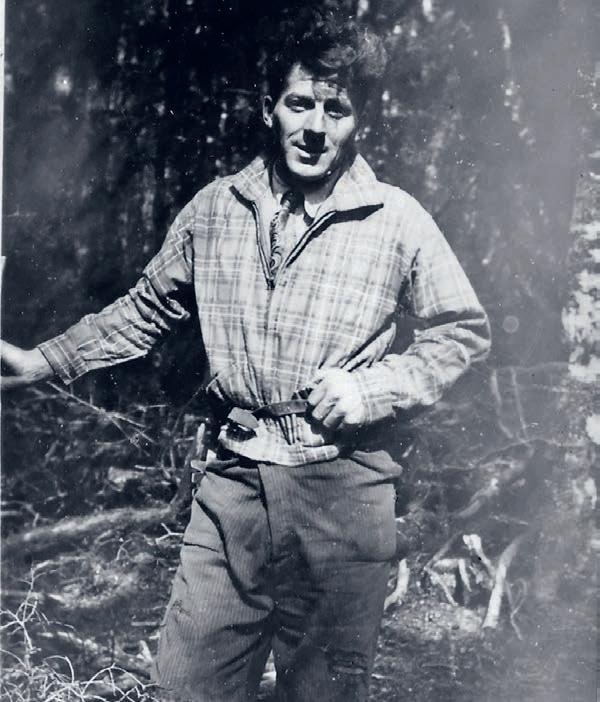
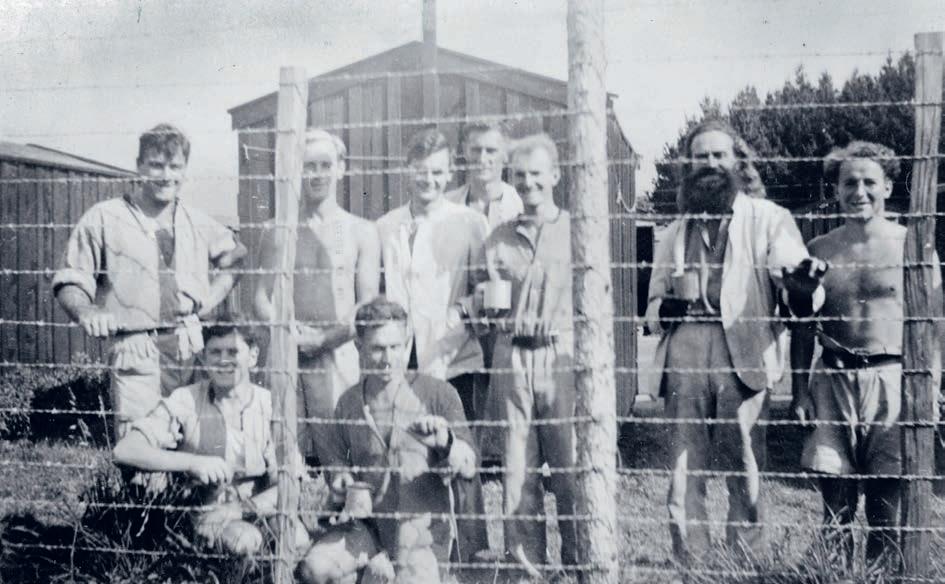
country. They seem to have been fed adequately, if photos are anything to go by, but the huts would’ve been miserably cold.
Bielski pointed out that the camps were a huge waste of time for those men. ‘Young people are now puzzled about why people were so angry about the conscientious objectors — people have moved on, and can’t understand how intense the feelings were,’ she told a reporter.7
I was much the same, and I said as much to Jeff. I also couldn’t comprehend how something like compulsory service would fly in a modern environment. ‘It took me a lot of time to get information out of my father,’ Jeff told me. ‘There are others who won’t talk about it, because of the stigma about conscientious objectors. Now that I’m older, I see the different generational perspectives on these things, if that’s a way of pu ing it. It’s hard to even begin to understand — I was only born in 1955. Trying to understand what happened with those generations, what they went through and how it affected families, it’s hard for newer generations now to appreciate how things went down.’
Jeff remembered Les from his childhood, although he doesn’t recall a lot about him or his activities on the mountain. ‘I just learned everything when Dad was ill and I’d sit there and talk to him, just chip info out of him.’ He reckons Les had no time for warfare and was extremely anti-authoritarian, particularly about the structure of governments, the military and the English. Jeff recalled that Les wasn’t arrested on Ruapehu like Merv was, and knew he was caught in the South Island somewhere. ‘He got arrested in the end because he dropped his ration book and it had his name on it.’
Jeff stumbled across one of Les and Merv’s huts when he was out deerstalking on Ruapehu one day, totally by accident. ‘I thought, I’ll be beggared. There was a noticeable clearing and I thought it wasn’t natural. I could see iron sticking out of the ground and hewn timber around. I made a note of it in my mind. I could find it again — I’d walk straight to it.’
︿︿︿︿︿
Living in the cold huts in a detention camp at Hautu was one thing, but Merv must’ve been a tough cookie already. Jeff described him as a proper Kiwi bushman, used to hunting and living off the land — he’d been all over the Moawhango, now within the Waiouru military zone. Merv would’ve been used to snow and ice, living rough and making do with whatever he had. He’d also lived through one of the worst disasters to hit Ohakune, and it happened while he was at large in the forest. In fact, it’s hard to imagine that the hut he was in wouldn’t have been affected.
In January 1942 a torrential flood, one of the biggest in history, hit Ohakune. The Mangateitei and Mangawhero rivers burst their banks and a railway bridge was washed away. Debris piled up against a bridge at Ohakune, diverting floodwaters into the street, pushing into people’s homes. It happened suddenly when a slip let go. Cars were overturned and the streets were li ered with dead animals — trout, eels, birds. It was the era of outhouses, and any longdrop near the riverbank was swept away. Ohakune became a wasteland of silt, slush and slash.
Ole Olsen was 79, had an artificial limb and walked with a stick. The owner of
Ohakune’s billiard saloon, Olsen was last seen alive at his premises in Clyde Street as the waters began to rise. The back door was about 20 metres from the raging Mangateitei Stream, and it’s thought he went to a end to some ca le. Search parties went down the Mangawhero River and up from Raetihi. His house had received the full force of the floodwaters — a later inspection found the bath was full of silt and water, indicating how badly flooded the dwelling had been. A er a couple of weeks, Olsen’s body was found in Memorial Park, 120 metres from his house, covered in dri wood and silt. Debris was banked up against trees up to a metre and a half high and included large logs and wrecked longdrops.
The damage had occurred over just two hours during the a ernoon. Farmers arrived with tractors to pull logs out of the main street, and a fund was opened for cleaning up and rebuilding. Ohakune stank; the stench from decaying mud, dead animals and debris was obnoxious, and locals were wary of an outbreak of disease, particularly from the filthy outhouses gone rogue.
Merv lived through the storm and flood, presumably huddled up by himself in one of the huts, a single man against the elements. He was a survivor.
Les’s granddaughter Susan Pulman also got in touch a er seeing my Facebook post. I was finding people were slightly wary of a random researcher/writer asking probing questions about their ancestors, but Susan was amenable enough. She wondered if Les ever got caught at all, because he had a close group of friends who helped him and supported him during the war.
‘Les would visit my grandmother semi-regularly, and he’d ride his bicycle up to the bushline, hide it in the scrub and then hike, usually one or two days, to one of his huts,’ Susan said. ‘There were two or three huts, all a good couple of days’ hike from each other.’ This all tallied with the multiple sets of coordinates I’d found.
‘He was a very adept bushman and was quite self-sufficient living off hunting and fishing. I don’t think Merv was with him, but I believe there were a couple of other men, they would meet from time to time but generally were quite solitary.’
Susan said Les spent time down south and in Australia shearing and working as a labourer or builder in the 1940s, and ironically he was employed by the Ministry of Works as a carpentry foreman during the building of the Waiouru army camp.
Les and Merv have a bit more in common. Both were habitual diary keepers — documents the families still hold — and both actually a empted to join other war efforts than the army. Les tried to join the Air Force as a single young man when he was 18 but because he couldn’t produce a birth certificate, as apparently his records had been lost in a fire, they wouldn’t let him in. And I found proof in Merv’s file that he had volunteered for the navy.
‘I’ve read some of Les’s diaries from that time,’ Susan said. ‘You can understand, as a married man with a young family — three kids under five years old — he was not keen. His father-in-law at the time was a World War I veteran who had suffered terribly with lung problems and also PTSD a er being gassed in the trenches on the front line.’
I found a description of the Bergersens’ huts while rifling through material at the Ohakune Library one day. Tramper Ashley Cunningham had collated a book of historical information, including photographs, and donated it to the library in the 1980s. He had been to one of the huts just a few months a er Les Bergersen was captured, led to the spot by a friend. His information tallied with the other material I’d found about the brothers and their huts. He wrote:
I believe he built, and used, two huts, one of which was not very far from the present Ohakune Ranger Station. The other was beside the stream west of the five-mile peg on Blyth Track. A friend showed me Bergersen’s hut a few months a er his capture. We delighted in the workmanship of it. It was built of kaikawaka, broadaxed so perfectly that the timbers and woodwork seemed almost to be sawn. It had a single room with a large open fireplace, bed, bookcase, table, chair and food cupboards. Under a loose floorboard was his broadaxe, but that had disappeared by 1949 when I last used the hut.8
The last time Cunningham had been to the site was in May 1987, when he found it challenging to locate because of the many changes in the forest and the stream. It took him hours to find. ‘By then,’ he wrote, ‘the hut had been reduced to scraps of decaying wood, and some old corrugated iron.’
Buoyed up by Ashley Cunningham’s booklet, I struck out up the Mangawhero Stream one day, dropping into the water itself via a well-worn deer track. It was only autumn, but the cold hurt my bones. The water was thigh deep in places, and the sides of the stream formed a sort of gorge. I soon turned back; although I’d le my intentions — details of where I planned to go and when I’d be back — it occurred to me that if I slipped on a mossy rock and knocked myself out, I’d drown long before anyone knew. I resolved to head back when daylight hours were longer, and I hassled my old mate Pete, aka Papa Smurf, for many months to come with me. I lured him in with occasional tales of the Bergersens until he finally relented and drove over from Hawke’s Bay for a mission. The Smurf had long been involved in Land Search and Rescue, and now that he was retired he was regularly chasing kiwi in the Kaweka as part of a tracking programme. Not only was he admirably fit for an old bugger, he was also adept at moving swi ly and stealthily through the bush.
We’d bashed up the stream, Papa Smurf finding animal tracks on the sides and moving far faster than I had on my last trip, and we got onto a sort of terrace between two catchments. I noticed he made almost no noise as he slipped through the trees, like fingers of fog swirling across the landscape. I turned back and looked at my other mate Pete, who’d also come with us. ‘It’s like he can smell it, eh?’ I said. ‘Years of experience.’
Pete nodded. ‘I can see why you wanted him to come.’ This Pete, in contrast to Papa Smurf, is a larger-format human and o en had to do combat with fallen branches rather than duck under them, but he didn’t complain. I recalled a scene in Barry Crump’s
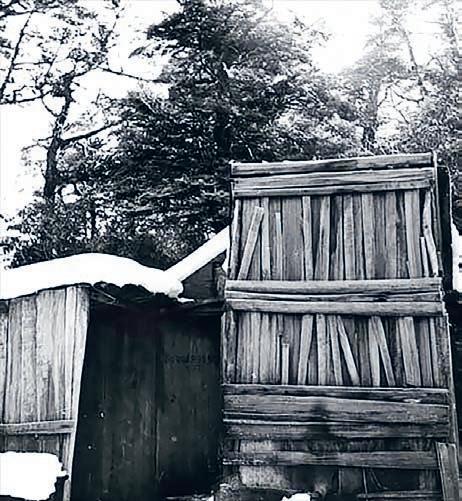
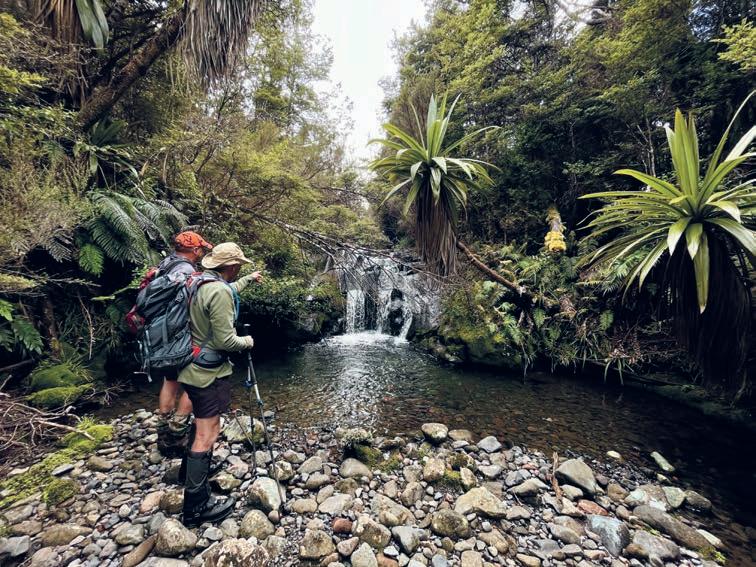
book Wild Pork and Watercress in which young Ricky Baker realises he’s learning how to weave his way through ferns, vines and branches. His Uncle Hec had chastised him: ‘If you try to break off every twig and fern that gets in your way, you’ll be worn away long before you’ve made any impression on the Urewera.’ I reckoned Papa Smurf was Uncle Hec in human form, and without the Child Welfare issues and police involvement.
We cleared the first set of coordinates easily — they were si ing straight on the stream bed and seemed to be wrong from the outset, because what flavour of idiot would build a hut in a stream? Then we headed to the second set, up on another terrace. We split up and conducted grid searches, staying within calling distance of each other and without result, but when we dropped down to the stream again we were all struck by the sight of a distinctive small waterfall and rock pool, fringed with moss and greenery.
‘Holy smokes,’ I said. ‘This would’ve been their swimming pool — Bergersens’ Bath.’
Pete agreed. ‘You’d make sure your hut was near to a good water source if things dried up, and having a bathtub like this would be handy long term.’
Back up on the terrace again, Papa Smurf asked a question he should have asked some time ago. ‘What exactly are we looking for, Shorty?’ (Although the Smurf is not so much taller than me.) ‘Is the hut still standing?’ And I realised I’d failed to include some critical information: that the ‘hut’ was mere scraps on the ground, if that, and that when Ashley Cunningham visited it in the 1980s there already hadn’t been much le .
Papa Smurf didn’t care, though, that I’d conned him into a wild goose chase; any mission was a good mission. It turned out he was familiar with Cunningham, who had been a proper bushman and known the Kaweka well. We concluded that his map markings were likely quite correct, but everything had been covered up during the four decades since anyone was last known to have been in there.
We had two needles, good strong needles, but a very large and unwieldy haystack.
In 2023 I tracked down Kaye Rabarts and David Wilton, two researchers and volunteers who had actually been to two Bergersen hut sites in 2008. Their photos showed that the upper site, in the Mangawhero and off the Old Blyth Track — in fact, the very set of coordinates we’d dismissed because they seemed to be right in the stream — sported corrugated iron remnants, a pile of stones that was a possible fireplace, and some broadaxed planks. They also supplied a photo of the distinctive metre-high waterfall in the stream that would work as a positive landmark for finding the hut, just up on the true right terrace. Wilton said they’d used Cunningham’s information the first time they looked for the hut, unsuccessfully, but the second time they went straight up the stream. ‘Bear in mind it’s just a sca er of overgrown rubble lying on the ground,’ he added.
Rubble was enough for me. Pete and I went back for another go in spring, while Papa Smurf was waylaid chasing kiwi or slashing through the Urewera with a machete,
or some other such bushman pastime. It took us 40 minutes to wind our way up the stream in warm, flowy conditions. The small waterfall worked as a stopping point, and from there we pushed up to the terrace, 10 metres above the stream, and there it was. There it was! Corrugated iron rose out of the ground, interspersed with plainly broadaxed planks, so cleanly hewn that they could have been sawn yesterday. An old beer flagon stuck up out of the dirt. I spo ed a door hinge and a pile of stones almost entirely covered in moss. We snapped photos and circled around the site, and hunted further for any other residual signs of life.
We were about to leave when I looked down at my feet. Unthinkably, on the ground, unobstructed by any other material, was the head of an axe. I picked it up, its he weighing on my hands. Les’s axe, or one of them, anyway. Probably used to split wood rather than cra the hut. But still: a clear sign, a remnant of the mighty Bergersen who had built the structure.
I read through sections of both Merv’s and Les’s diaries, which gave me an idea of what daily life was like for them. Both Bergersens were occasionally poetic in their scribblings. Merv wrote in March 1942 of going for a swim in the twilight in a pool in the Mangaturuturu Stream:
I noticed a waterfall and knowing there would be a fine swimming pool under it down I went. And there was a beauty, although a bit late I couldn’t resist . . . the water looked very tempting and stripping off, in I went, but there was already ahead of me two lady birds and a locust which had got out of their depth and were struggling like hell to get back. Rescuing these, I se led down to a quiet bit of splashing around.
Merv routinely made trips back to Ohakune to see his family and get vegetables, and in fact Jeff reckoned the newspaper reports were wrong: he wasn’t arrested at the bush hut, but in the paddock behind the family’s home while helping them harvest potatoes.
He constructed a window in his hut, and wrote: ‘I am beginning to be a champ (not chump) carpenter with a hatchet, hammer and saw. The sun will be able to shine in on the table now, when it shines . . . now as I see the moths crawling on the window, trying to get in to the candle light, it looks more like home . . . goodnight.’
He also wrote about going deerstalking with a friend he calls simply ‘X’. Their stag weighed about 45 kilograms, and they carried it from high up on Ruapehu down to the hut, stopping at Ohakune Hut on the way. Some trampers had just le and the fire was still burning. Merv and X had no food with them, but the trampers seemed to have had plenty; in the fire was about a pound of luncheon sausage, which was ruined but they ate it regardless. Outside in the tussock was a discarded small loaf of bread, a bit damp but a welcome find, and inside they found bu er, tea and milk. ‘A er scraping the mouse droppings off, this seemed alright, so with what we found outside and inside, it made quite a good supper.’

ABOVE: An axe head found in 2023 that probably belonged to Les Bergersen.
BELOW: The remnants of Bergersen’s hut in 2023.
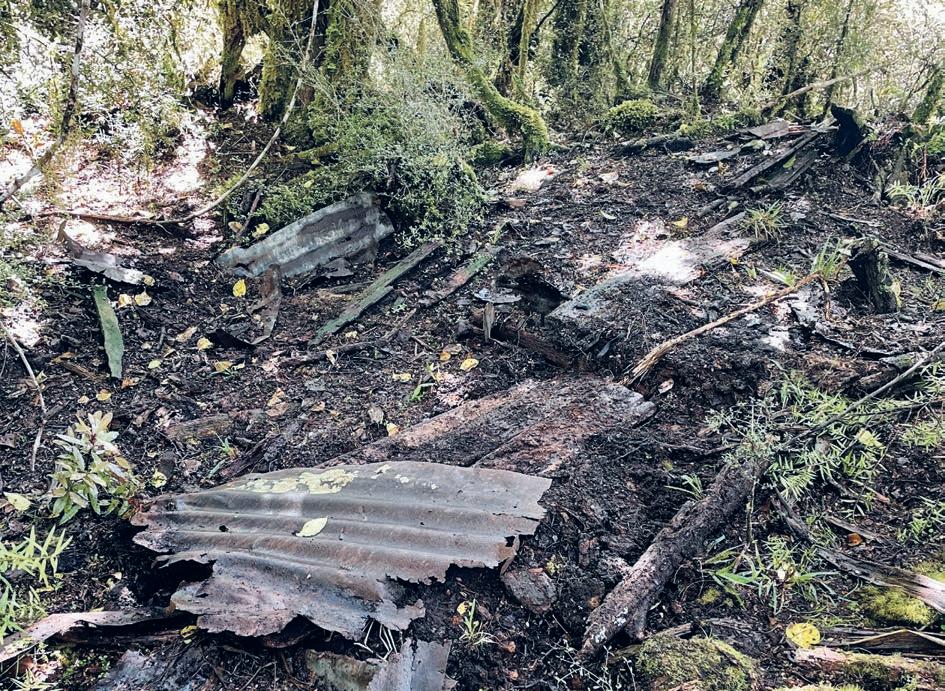
They sandwiched themselves between the ma resses in front of the fire, which Merv deemed much be er than sleeping out in the bush. ‘When the trampers threw away that loaf of bread they would have had no idea that some hungry deerstalkers would find it and be very thankful.’ On their way home the next day, Merv and X came across half a cake of Cadbury’s chocolate in the creek, which they consumed with delight. ‘We are living on what they have chucked away,’ Merv commented to X. ‘First the bread, now the chocolate.’ X responded: ‘Yes, if we knew where they lived, we wouldn’t have to work any more.’ On returning to his hut, Merv cut some maggots off a piece of old roast pork and ate it with roast potatoes, rice and a cup of coffee.
At one point in 1942, Merv described a trip with a friend to Waihohonu Hut, where they arrived late and exhausted, to discover the hut was full of soldiers. The chaps gave up their bunks and offered them chocolate, and peaches covered with condensed milk. Merv reflected: ‘Li le did these soldiers know that I was a conscientious objector that had ignored four notices to proceed to camp — if they had known their hospitality might not have been so great.’
Les’s diaries make for a gripping read; he records several close calls where he nearly got caught, and at times had to hide in long grass until darkness fell. He was supported by a couple of close friends, whom he trusted and relied on for help when needed. ‘What a beautiful world this would be if the masses were to see, believe and act as my friends do,’ he wrote. ‘Help one another. All men equal, no race or class distinction and no war.’
Les o en made trips back to the family home in Ohakune, driven by the desire to see his kids. He had close calls there, too, and wrote of one incident where his son got excited and revealed to visitors that his daddy was home. ‘It’s a fine flag we live under when one has to punish his children for telling the truth all because his father refuses to murder for the stinking capitalist . . . I love my family and want to be where I can see them now and then.’
In a February 1943 entry, Les wrote of telling his son he had to leave again — either he had to head off to go shearing, or go to war and kill some other li le boy’s daddy, he told him — and his son cried.
‘If he only listens like he did tonight and takes heed of what I tell him in regard [to] war he will never don the khaki and cause sorrow and grief to millions.’